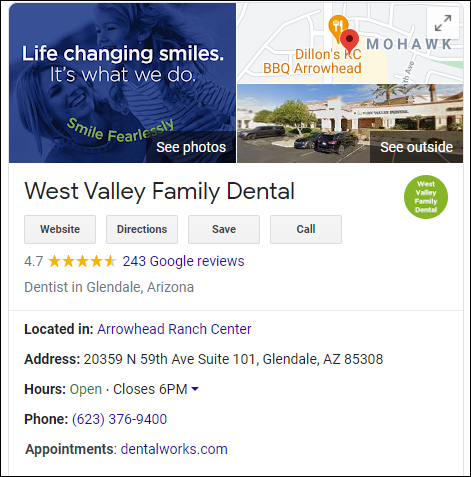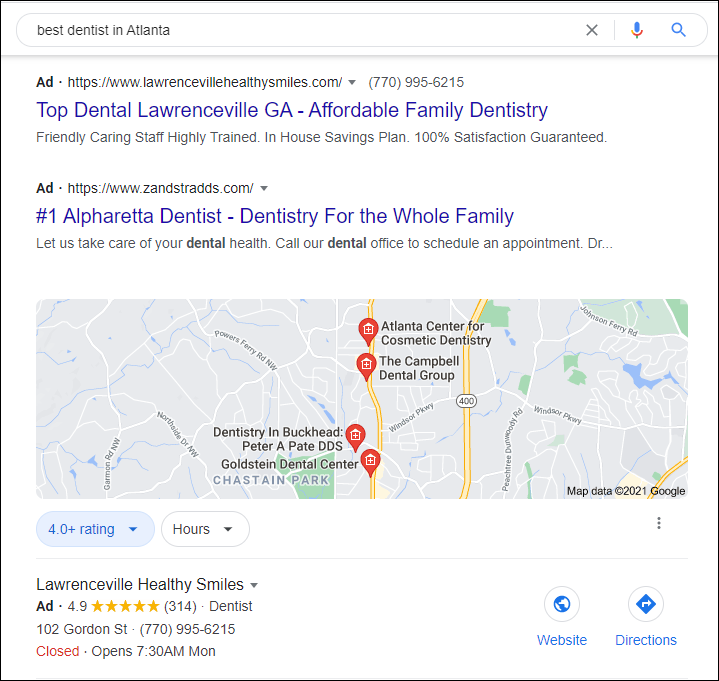For DSOs, it can be a challenge to achieve a balance between patient acquisition and patient experience. We’ve written a bit about marketing’s role at each step of the patient experience; suffice it to say, the two should not be mutually exclusive. For the purposes of this article, I’m going to focus more closely on patient acquisition.
Table of Contents
- 1. Centralize Your Marketing Strategy First
- 2. Take Your Local SEO Very Seriously
- 3. Shore Up Your Brand Reputation Management
- 4. Launch and Optimize Your Google Ads
- 5. Optimize Campaigns for Efficiency (aka Conversion Rate Optimization)
- 6. Build Reliable Marketing Analytics & Real-Time ROI Measurement
- In Closing: Build a Foundational, Repeatable DSO Marketing Strategy
As you’ll see below, marketing plays an essential role in patient acquisition for DSOs. From the first moment a person goes online to look for a dentist in their city to how, why, and when they decide to make an appointment, digital marketing is pulling the strings.
That said, things get complicated for multi-location groups with existing marketing silos. So I’ve put together the six essential areas to consider when setting up your own DSO marketing program. In my experience, close attention to these marketing strategies will support both high-growth patient acquisition goals and a strong patient experience alike.
1. Centralize Your Marketing Strategy First
You’re unlikely to achieve efficient and rapid patient acquisition without a streamlined marketing strategy.. Rather, DSOs need a solid digital marketing foundation capable of supporting multi-location scalability. In our recent experience working with DSOs, we’ve found that disparate, siloed marketing operations are one of the most common obstacles to achieving this kind of scalability.
Instead, we recommend centralizing your DSO marketing strategy. To that end, I’m sharing three takeaways from our full guide to centralization, How Marketing Centralization Helps DSOs Accelerate Growth:
SEO
It’s not easy to manage SEO separately for all your member practices, nor is it particularly effective. Instead, try centralizing your web properties for a more unified SEO strategy. That means you only need to manage technical SEO, marketing content, link building, and so on for one web property instead of many.
Pay Per Click (PPC)
With PPC for DSOs, efficiency is the name of the game. You’ll want to keep the cost per conversion, cost per acquisition, and other key metrics in check with a consolidated, streamlined account structure. By consolidating your ad account, you’ll be able to rely more effectively on Google’s smart bidding to make efficient bidding decisions. And you’ll reach more new patients for less budget, too.
Marketing Technology (MarTech)
It’s hard to foster transparency, collaboration, and visibility across disparate marketing systems that don’t talk to each other. You’ll find that streamlining your marketing tech stack across your group can help reduce redundancies and save costs in several ways. Of course, consolidating the following systems is no small undertaking:
- Customer relationship management (CRM)
- Marketing automation software
- Call tracking
- Social media management
- Listing management tools
- Marketing analytics
2. Take Your Local SEO Very Seriously
How far are you willing to drive to see your dentist? Not far, if you’re like most people. In the end, dental care is a local service. People don’t drive far to seek dental care—they want the convenience of something close to home. This is why local SEO is a core part of any DSO marketing strategy.

Yet, a multi-location strategy for local SEO can be tricky. Whereas centralization is great for DSO web properties, marketing technology, etc., it’s better to have location-specific and location-optimized business listings online. Your Boise-based practice, for example, needs its own citations and listings, Google My Business (GMB), and a location page on the website. The same goes for your Phoenix and Chicago locations, respectively.
And all of these location-specific listings should conform to a location-specific keyword strategy. This is how new patients will find you when looking for dentistry services in their city.
For more tips on local SEO, read The Insider’s Guide to Local SEO for Dental Groups and DSOs.
3. Shore Up Your Brand Reputation Management
Each member practice in your DSO has its own digital reputation to manage while also conforming to the brand standards. In many ways, digital reputation management is closely tied to local SEO. When people are searching for a new dental practice, they’re likely reading reviews, too.
According to research from NRC Health, 60 percent of patients have decided against a healthcare provider based on negative online reviews—34 percent consider online reputation to be “an important part of their decision-making process.” Reputation also plays a role in referrals and word-of-mouth marketing.
Each member of a DSO must have a strong reputation if they want to attract new patients in their respective markets. Here a sampling of reputation management best practices you ought to know about:
Check Your Listings Twice
Take a moment and Google one of your member practices. What do things look like on the search results page? Do you see a complete GMB listing with accurate information, links, ratings, and reviews? What if you use Google Maps to search for a dentist in a particular city? Will one of your member practices show up in the search results?

Step one in reputation management is to take an inventory of all your digital listings and the state of their reviews. You’ll want to check dentist review sites and dental and insurance group listings. Look at Google My Business, Yelp, and Facebook Business, too. And don’t forget healthcare-specific databases, such as Healthgrades and 1-800 Dentist.
Finally, if you don’t have listings in these places, it might be time to create them. If you do, how many reviews does the location have?
Keep the Reviews Coming
The quality, frequency, and sheer volume of your ratings and reviews matter. To build a more formalized process for regularly soliciting patient reviews, try to identify points of the patient journey where it makes sense to ask for feedback, such as:
- At the front desk (in-person)
- After an appointment (by email or text)
- After a procedure (by email or text)
I’ll note that you’re unlikely to accumulate the volume and frequency of reviews you need just by waiting for them (organic reviews). Those will come, but what I’m talking about is a more sustained program for generating reviews.
Roll Out Reputation Management Software
There are also programs that help automate review solicitation, management, and reporting. For example, some integrate review solicitation with email, SMS, or even regular mail. These solutions make it far easier to regularly solicit reviews, respond to them, and monitor digital reputation overall. Examples include Birdeye, Podium, and TrustPilot.
To learn more about reputation management for DSOs, read:
4. Launch and Optimize Your Google Ads
Don’t get me wrong: SEO—and local SEO, in particular—should be a pillar of any DSO marketing strategy. However, SEO is not the strategy to rely on for immediate lead generation and patient acquisition. For that, PPC remains one of the fastest, most cost-efficient ways for dental practices to bring in new patients.
There’s a couple of reasons why Google Ads make sense for your DSO marketing strategy.
For one, Google PPC ads can capture the attention of people at the bottom of the funnel who want dental care now. The healthcare consumer with an urgent dental issue—real or perceived—might be ready to click an ad off a quick Google search to book an appointment. Likewise, you can run campaigns targeting high-intent search terms like “dentist open near me”, or “best dentist in Atlanta” to drive leads much faster than traditional campaigns or SEO.

More generally, PPC allows you to “buy” rankings immediately, rather than waiting for your longer-term SEO plays to gain traction. Done correctly, you can place an ad in search results that starts delivering patient leads as soon as today. Only, we recommend following a few best practices so you don’t blow your ad budget on bad leads:
A few tips for a better Google Ads strategy:
- Refine your keyword strategy
- Optimize your campaign structure
- Test call-only ad campaigns
- Deploy ad extensions for improved engagement
- Optimize your campaign landing pages
- Build out location-based targeting
- Automate appointment reminders to reduce no-shows (and improve ad conversion rates)
You can read a full explanation of each of these tips in 7 PPC Advertising Best Practices for DSOs and Dental Groups.
5. Optimize Campaigns for Efficiency (aka Conversion Rate Optimization)
Conversion rate optimization (CRO) is a broad discipline that extends to design, mobile, website experiences, and so on. At its core, CRO is the process of continuously evaluating campaigns and making optimizations that improve conversion rates. The goal is to get more efficient by increasing conversion volume, reducing cost per acquisition (CPA), and increasing the lead-to-sale ratio—ideally all at once.
CRO can be a potent way to get more out of all of your marketing efforts—not just paid media. You can get more out of your SEO traffic and conversions, for example, or reduce the bounce rate on your website’s appointment page. And we’ve seen DSOs achieve massive improvements to their conversion rates by investing in a mobile/responsive website overhaul.
Having worked with a strong portfolio of healthcare clients, I’d estimate we see an average 30 percent improvement in conversion rates with sustained attention to CRO best practices. Here’s a couple of best practices to focus on:
- Make it easy to schedule appointments
- Provide multiple ways to book an appointment
- Enrich your site and landing pages with the info people need to make a decision
- Optimize for mobile experience across the board
- Deploy social proof and testimonials to build trust
- Appeal to location-specific audiences
- Make it easy for people to get what they need by skimming text
For an in-depth look at CRO best practices, see 7 Tips for Improving Conversions and Driving More Appointments.
6. Build Reliable Marketing Analytics & Real-Time ROI Measurement
In and of itself, data-driven marketing is essential. It’s how we make informed decisions about strategy, purchase decisions, and down-stream campaign adjustments. It’s how we connect the dots to understand if the investments we’ve made are producing adequate returns.
For a multi-location DSO, there are many dots to connect with data across many different locations. Guess what the primary obstacles are to better visibility, collaboration, and reporting? Data silos and disparate, disconnected data systems.
That’s why we recommend DSOs make an effort to integrate their marketing systems and data operations. That means eliminating organizational data silos by bringing data sources together and systems together. A common example is an integration between Google Ads, call tracking, and an existing revenue management software. That effort alone can lead to tremendous insight into the performance of your paid media strategy.
Then it’s time to build your data team, assign responsibilities, and talk about expectations around capabilities, KPIs, reporting, and so on. This is also an opportunity to do two crucial things:
- Establish and communicate organizational goals, KPIs, and industry benchmarks
- Determine your attribution model (first, last, multi-touch, linear, time-decay, u-shaped, w-shaped)
Finally, you need to democratize data across the organization. Think about how you can make it easier to access, build, share, and collaborate on reports. This will lead to better alignment and visibility between different levels of the organization, as well as different business units or even locations.
For more tips on data-driven marketing, read Building a Foundation for Better ROI Measurement.
In Closing: Build a Foundational, Repeatable DSO Marketing Strategy
Things move fast in the world of healthcare. Digital marketing for dentists is highly competitive and very saturated. In a given city, you’ll have dozens of practice competing for views, clicks, traffic, and conversions. Here’s what the Google Maps search for “dentist” looks like in Charlotte, a city I visited this past year:

Extrapolate that kind of saturation to multiple cities throughout the United States, and you have an idea of what DSOs are up against. You have a much clearer picture as to the urgency of a foundational and repeatable marketing strategy, too. And that’s the keyword: repeatable. When you take the time to build a thorough marketing strategy suitable for DSOs, you make it far easier to get new practices and locations up to speed quickly.
Isn’t that the definition of a scalable marketing strategy?

